Out of the box, no configuration is necessary to begin entering projects. A default category and project type is created for you to use. But not to worry, you can create as many or as few categories and project types as you need.
Categories
Categories are only used for organizing projects of varying types into a single view. You may, for example, want to have a category for all Media projects. Even though the different projects in that category might be of different project types. Another example, Video Requests and Graphics Requests might be two different project types, but the projects for all of those may get put in the same Media category.
Categories can be added through the Installed Plugins > Project Management > Project Categories page.
Browsing Projects
You can browse projects in one of two ways. First, by using the "Projects" menu which presents projects in a manner similar to how Content Channels are organized and viewed. The second option is the way projects were viewed in version 1.x, which was via the category viewer.
The category viewer is the "Project Tree" page. It lets you view all the projects associated with a single category. That is the benefit it has. However, the downside is its a bit harder to quickly get an overall view of projects, what is assigned to you, etc.
The recommended way to view projects in version 2.0 is to use the new "Projects" page:
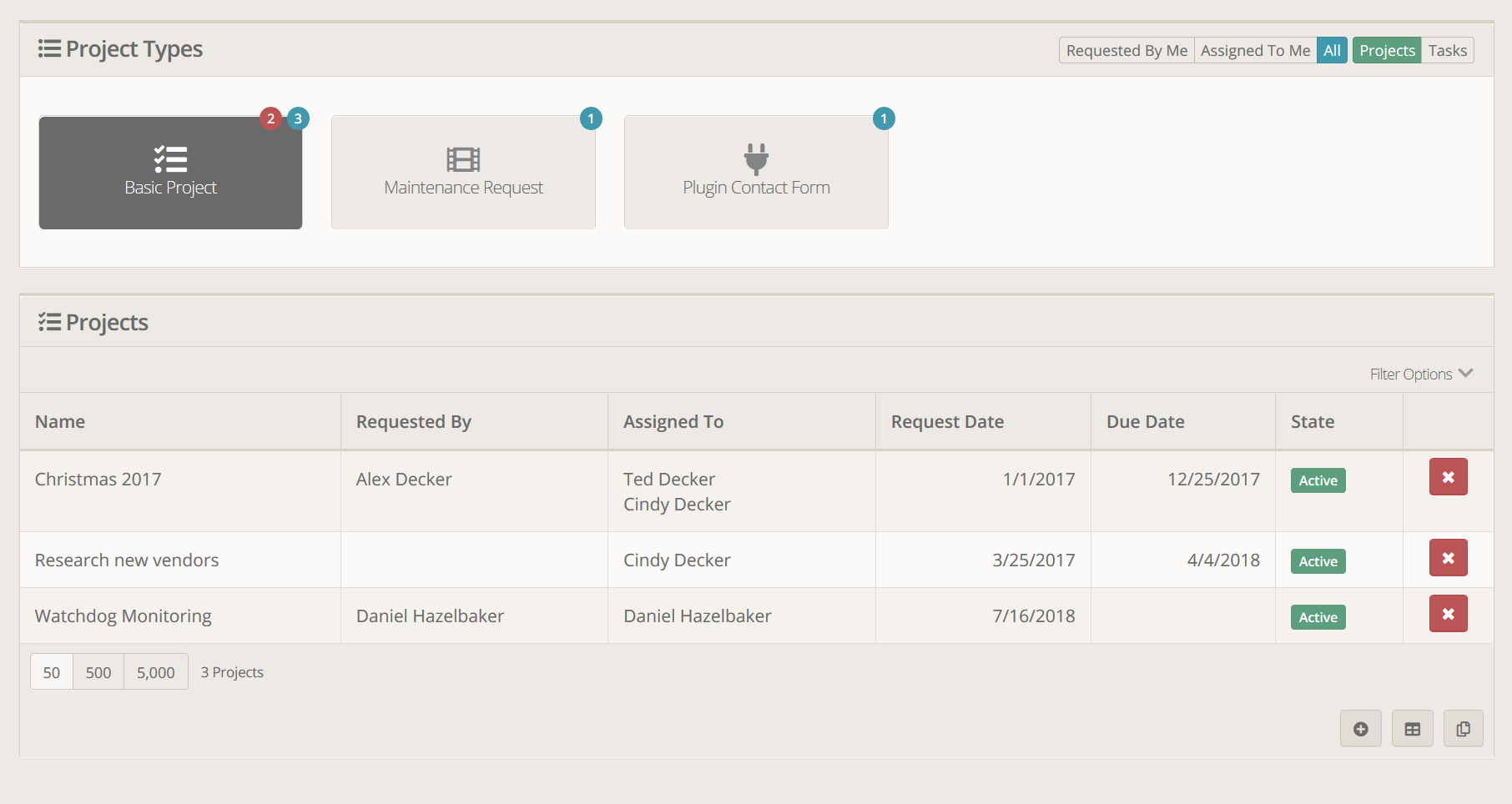
If you are familiar with content channels, this will look very similar. But lets cover a few of the features real quick. First, because you are looking at a single project type at a time the Show on Grid flag of custom attributes is honored. This means you can see those attributes on the grid and even filter them.
The second major feature is the little buttons in the panel header. There are two sets. The first lets you switch between viewing All projects, just those Requested By Me (you), or those Assigned To Me (you). This provides quick filtering to see both the list of projects and the number of projects as these selection also change the bubble counts on the project type buttons.
The second grouping of buttons lets you switch between viewing Projects and viewing Tasks. Yep, you can quickly switch your bubble counts and grid list to show tasks instead of projects.
Project Types
Project Type configuration is done through the Installed Plugins > Project Management > Project Types page. From here you can add, edit and remove project types from the system. You can also view a list of all projects for a given project type.
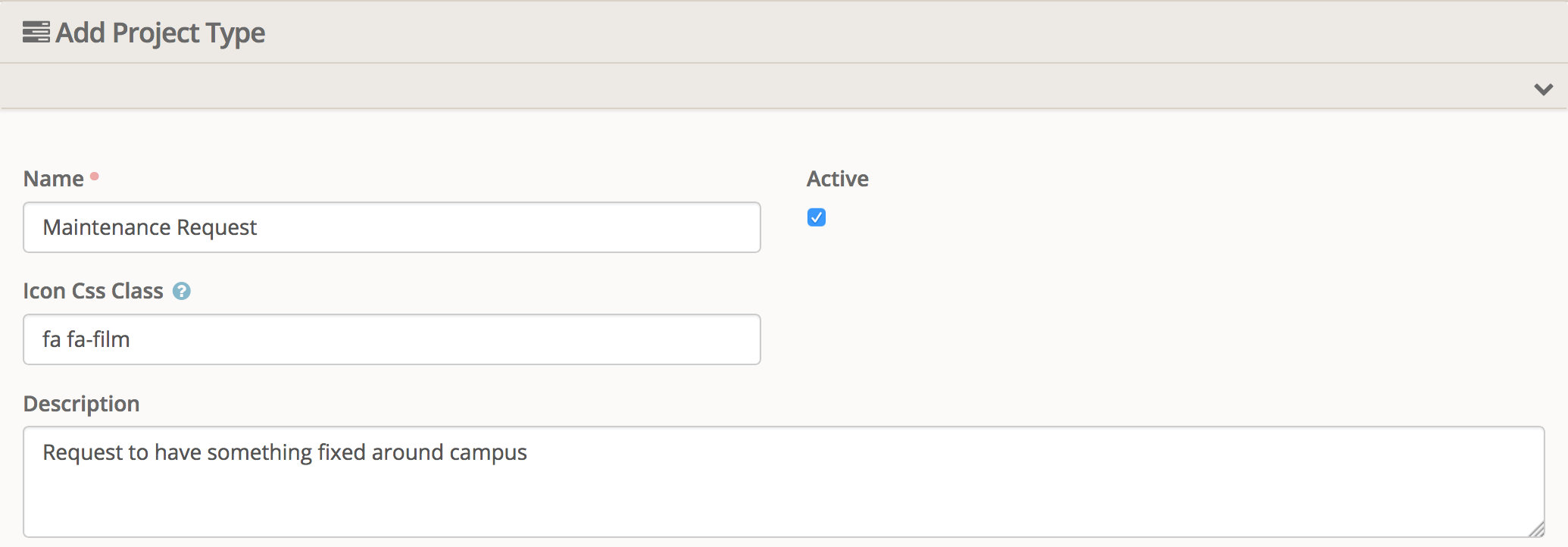
If you have used Rock for any period of time, you should be familiar with these various fields. The name is what will be displayed in the UI whenever this project type is referenced. A project type can be marked not-active and this will prevent users from being able to create new projects of this type. The icon class is used on various pages to help identify projects of this type visually. Finally the description is an internal field that you should use to describe in as much detail as you can when this project type is to be used.

Anytime a file is uploaded and attached to a project description or a comment it will be saved using the file type that is specified here. This does not set the file type of any attributes you add below. This is only for files that are attached via the text editors.
The four e-mail fields let you specify the system e-mails to use for any projects of this type. If you leave the field blank then that specific e-mail will not be sent for this project type.
The Child Project Types behaves similar to the child group types with your group structure. This field specifies which project types can be made sub projects to a project of this type. Sub projects will be discussed in more detail further below in the documentation.

These next fields are optional and only matter if you want to customize how the formatted name of both Projects and Tasks of this type look. By default the standard name will be used if you don't fill anything in. These are Lava aware fields that you can use to format and style with HTML how the name is displayed.
In the screenshot above, we are customizing the the way both names will display in supported blocks. For the project, we are displaying the project type icon followed by the name. In the case of the task, we are displaying the task name and then on a new line we display in a smaller font the name of the project. Note the use of the Escape filter with the names. Because the FormattedName fields are HTML, we need to make sure to escape any characters in the user supplied names that might not be valid HTML.
The blocks that will use the FormattedName by default are:
- Project View
- Sub Project List
- My Projects
- My Tasks
While each of those blocks will use the FormattedName by default, they each also provide a way to use the unformtted name instead. Each block has a setting that provides a lava template to use for the Name of the project or task. If you wish to revert to the unformatted name then you can change those block setting templates.
[!CAUTION]
Make sure you do not attempt to use the FormattedName instead of the Name property. If you accidentally try to use the FormattedName inside one of these templates you will probably crash your Rock server since it will cause a recursive loop trying to resolve that field over and over again.
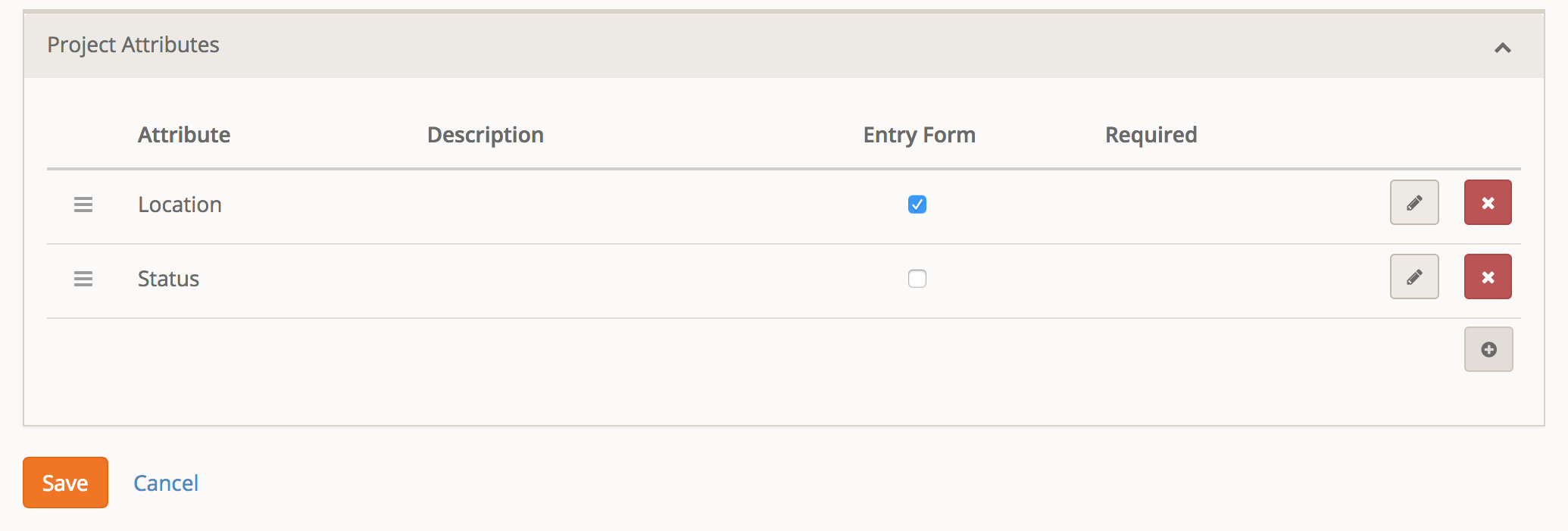
You know about properties. You've made a few. You probably even wish you hadn't made some of the attributes you've made. Project attributes work just like attributes on any other entity. The only thing you will probably notice different is the additional checkbox for "Entry Form". Any attribute that is flagged for "Entry Form" will be visible on the project entry screens. This allows you to have attributes that are available to the user when they enter a new project and other attributes that are only available to those that can edit an existing project.
Project Entry
Project entry normally happens through a dedicated page. This page hides a number of fields that normally shouldn't be visible to the requester. A few examples are the project type, category and due date to name a few.

To enter new projects, you should direct users to the Tools > Project Entry page. This pages shows any configured projects that can be requested by the users. Each button is essentially a combination of the Category, Project Type and Default Assignees. For example, you may have multiple buttons for the project type of General Projects, but each button creating the project in a different category and a different person assigned by default.
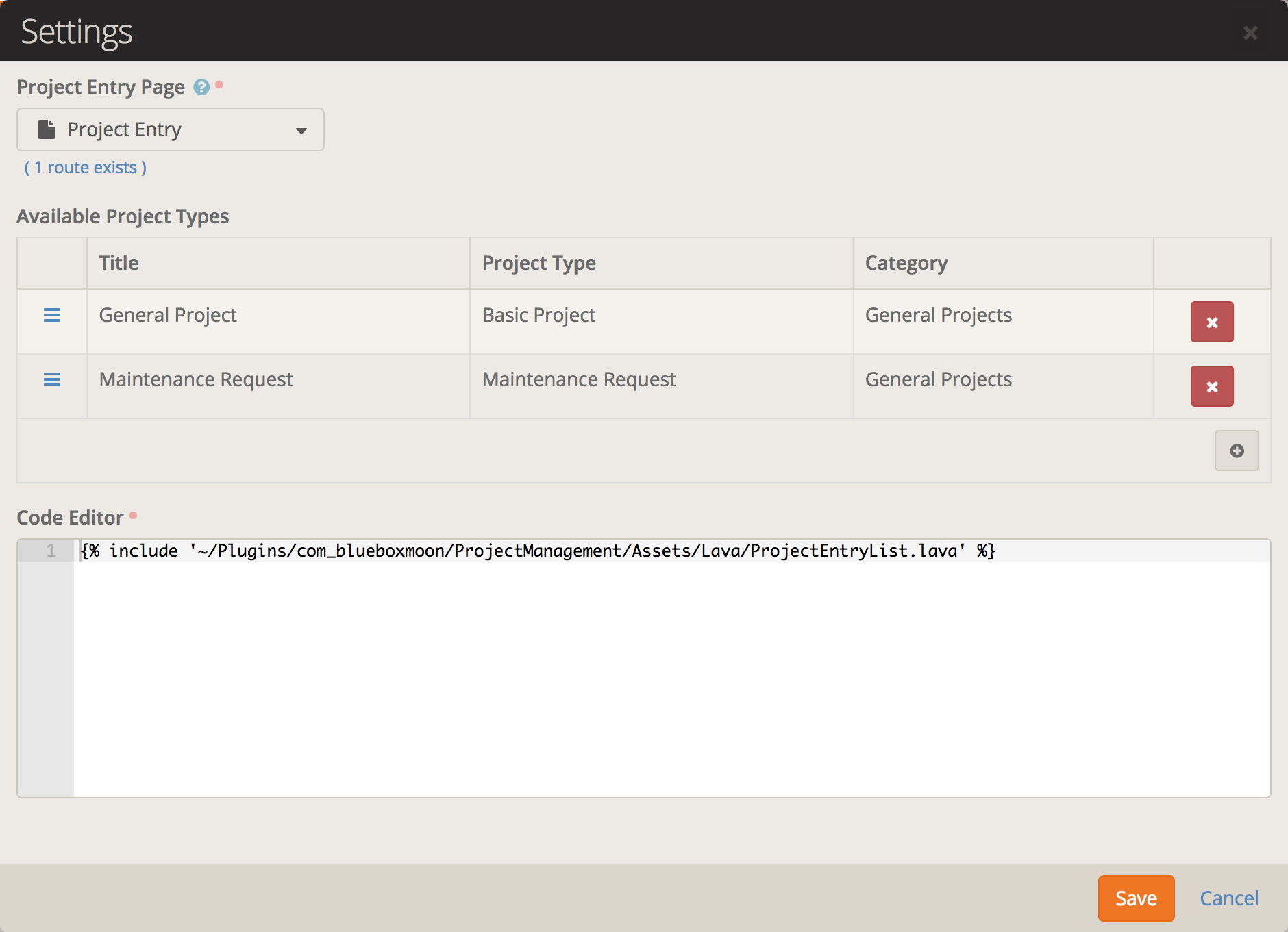
The list of which buttons are available is available in the block settings. The settings allows you to specify the Lava Template used to render the buttons, in case you want to override the default layout. Finally, each button is configured as a line item in the settings. You can have a project automatically assigned to either an individual person or a group of persons. Because this is all done as a block setting it means you could create additional pages to further divide up the buttons.
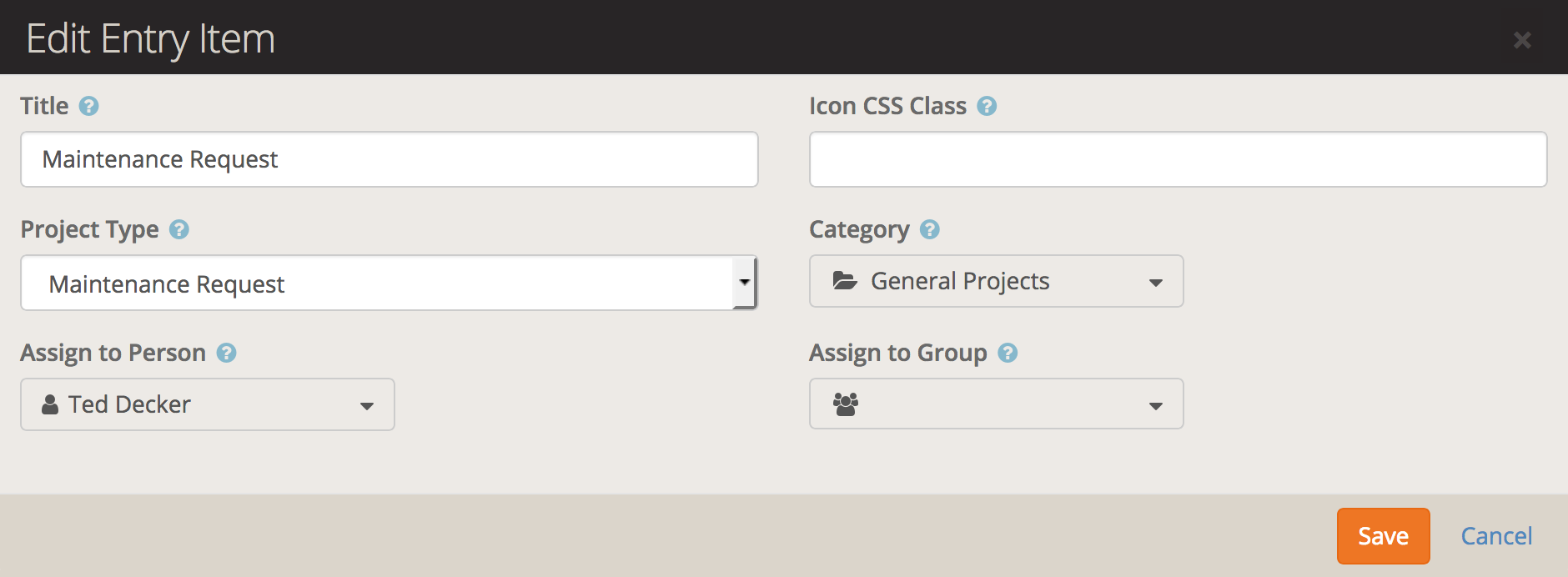
Adding a new item to the project entry list is straightforward. Give the button a title, project type and a category. By default the button will use the icon from the project type, but you can provide your own icon class for this button.
If the project should be automatically assigned to a person then you can select the person here. They will be assigned and receive an e-mail (if configured) automatically. If you need to assign multiple people you can place them in a group and select the group. Each member of the group will be assigned to the project.
[!NOTE]
A project can only be assigned to people. When using the Default Assignee Group then the project gets assigned to any active members of the group when the project is created.
Dashboard Blocks
There are two blocks that can be added to your users' dashboard page if you want to put them in. One shows projects for the user and the other shows tasks.
My Projects
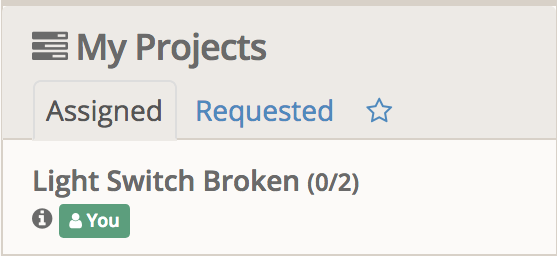
The My Projects block allows the user to view three different collections of projects: Assigned to them, Requested by them, and Followed by them. Clicking on the project name will take them to the project detail page. Each item contains a summarized version of the details of the project:
- Project Name
- Number of completed/total tasks
- Description of project (by hovering over the info circle)
- If project is currently blocked
- Due date (if any)
- Who project is assigned to
There is a block setting that lets you customize how the Project Name is displayed. This setting is Lava enabled which gives you lots of customization ability.
My Tasks
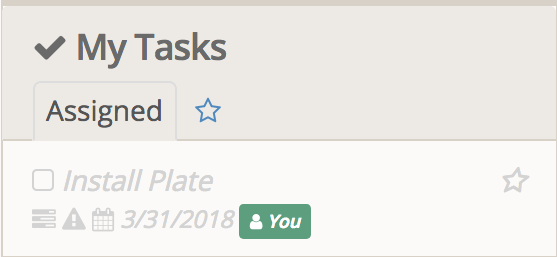
The My Tasks block alows the user to view two different collections of projects: Assigned to them, and Followed by them. Clicking on the task name will take them to the project detail page for that task. Each item contains a summarized version of the details of the task:
- Task Name
- Description of project (by hovering over the info circle)
- Name of project this task belongs to
- If task is currently blocked
- Due date (if any)
- Who project is assigned to
There is a block setting that lets you customize how the Task Name is displayed. This setting is Lava enabled which gives you lots of customization ability.
Calendar Settings
There aren't really any block settings you would care about here, but there is one very important customization you should be aware of.
The calendar uses 32 color schemes when displaying different project types. This makes it easier to see different what project type a task or project is. But sometimes these colors may not really fit the project type. We make it easy to override these colors with CSS.
Each item on the calendar is flagged with an event class as well as a second class that indicates the project type Id. For example, project type id 11 would have the class project-type-11. If you wanted to override the colors of all project type 11 items then you could add some CSS to the page like this:
.event.project-type-11 {
background-color: #006000;
color: #ffffff;
}
Other Block Settings
Project View
The project view block is the one you will be using most when browsing projects and tasks, it can be reached via the Tools > Projects menu. There are a few block settings you will want to be aware of. These are the Project Name Template and Task Name Template. These allow you to customize how the name columns of the project and task grids are displayed. By default these will use the formatted names which can be defined on the Project Template.
This means you have two ways to customize how the projects and tasks are displayed. For example, on a single project type you can modify the formatted name to include a Font Awesome icon in certain conditions. Additionally you can use these block settings to do additional customization - for example, show the first 90 words of the project description on a second line in smaller text for all project types.
A second point of customization on this block is the ability to add custom columns. These are added just like on any other block that allows custom columns in Rock. The primary difference is that the since there are two grids displayed for this block, we have supplied a way for you to pick which grid these columns show on. By default, any custom columns will display on both grids. However, if the Header Class for the custom column contains the word project then it will only be displayed on the Project grid. Conversely, if the Header Class contains the word task then it will only be displayed on the Task grid.
In either case, the Project or Task for the respective grid can be access in Lava by the Row variable.
Email Notifications
If you use either Mailgun or SendGrid then you can configure Rock to let you leave comments on a project simply by replying to the e-mail notification. The only configuration in Rock you need to do to support this is to ensure that your e-mail templates have the correct subject line (see templates below) and then to set a From Address for each template.
The From Address can be anything, but it must correlate to the address you setup in either Mailgun or SendGrid. So for example, if you setup Mailgun and use project-comment@mg.rocksolidchurchdemo.com as the e-mail address, then you will need to update the four out-of-the-box System Emails as well, as any custom system e-mails you setup, to use project-comment@mg.rocksolidchurchdemo.com as the From Address.
After ensuring the e-mails are being processed correctly, we recommend one final change to the e-mail templates. Telling users by word of mouth that they can reply to an e-mail and have the comment saved is all well and good, but wouldn't it be easier to just include that information in the e-mail itself? Out of the box, the e-mail templates contain this at the end of the messages:
<small><a href="{{ Project.Id | BBM_ProjectRoute }}">view it online</a>.</small>
We suggest changing it to the following to make it clear to the user they can just hit reply:
<small>Reply to this email directly or <a href="{{ Project.Id | BBM_ProjectRoute }}">view it online</a>.</small>
Mailgun
Mailgun allows you to configure individual e-mail addresses to be delivered to different API endpoints. You will need to configure a single e-mail address and have it deliver those to Rock. We suggest something simple, such as project-comment@mg.rocksolidchurchdemo.com, but you can use anything you want as long as it gets to Rock. The important part is the Subject line. When you configure the API endpoint you should enter the following (putting your Rock domain name instead):
https://rock.rocksolidchurchdemo.com/Webhooks/ProjectCommentMailgun.ashx
To configure Mailgun, go to your Routes menu and add a new route. Expression Type should be Match Recipient. Next put the e-mail address you want to use in the Recipient text box. Finally turn on the Forward action and enter the URL to the Rock Webhook (see above).
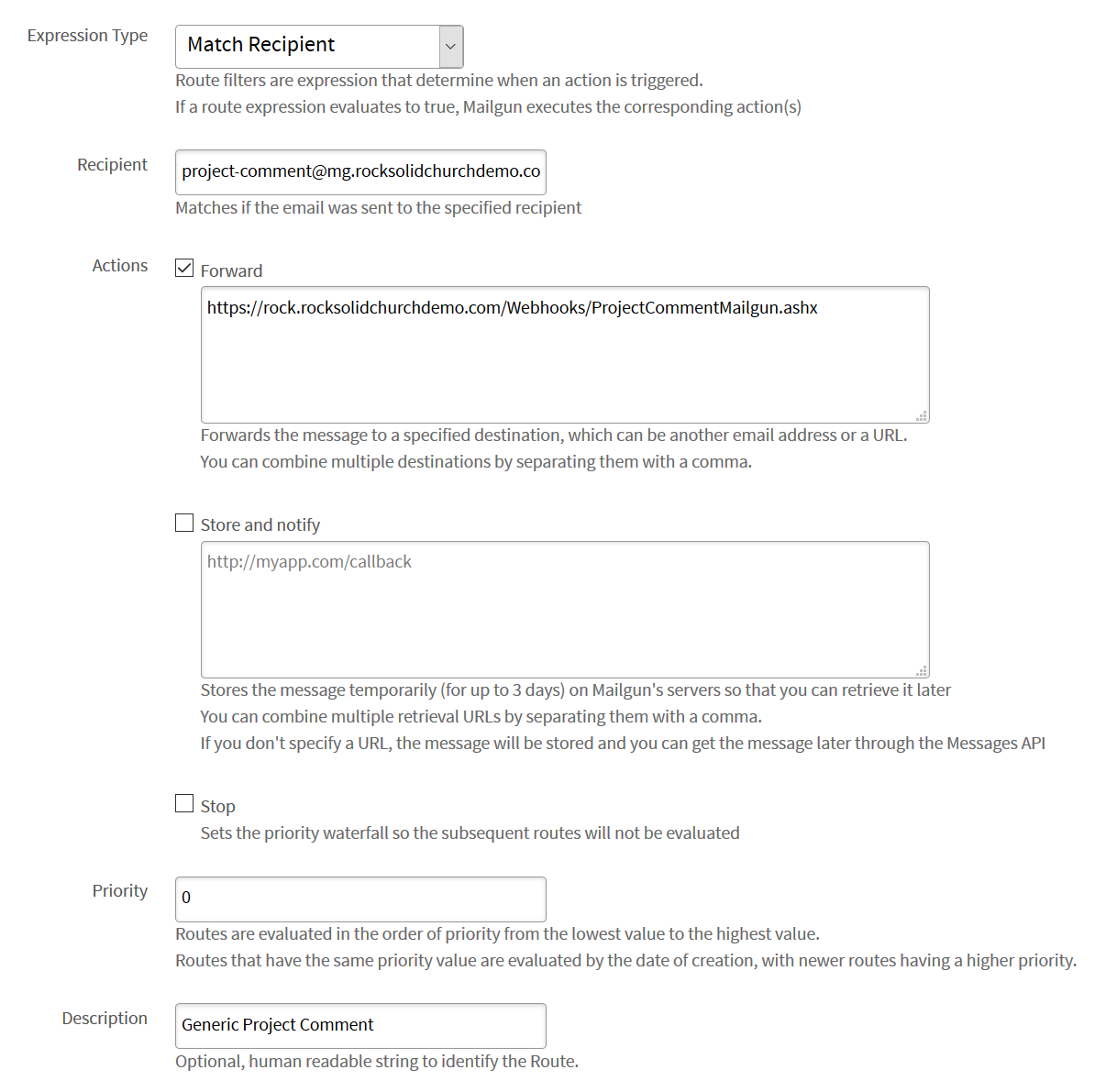
SendGrid
SendGrid forwards all e-mails to a specific domain to a single API endpoint. This means you will need to configure a subdomain to use for project comments. For example, we would recommend that you use something like projects.rocksolidchurchdemo.com for the domain and then comment@projects.rocksolidchurchdemo.com for the actual e-mail address. The important tracking details are in the Subject line so you can use any e-mail address and domain name you want as long as it's configured correctly in SendGrid to send those to Rock. When you configure the API endpoint you should enter the following (putting your Rock domain name instead):
https://rock.rocksolidchurchdemo.com/Webhooks/ProjectCommentSendGrid.ashx
To configure SendGrid, go to your Settings > Inbound Parse and add a new entry. Select your verified domain name and enter the subdomain you want to use, then enter the URL to the Rock Webhook (see above).
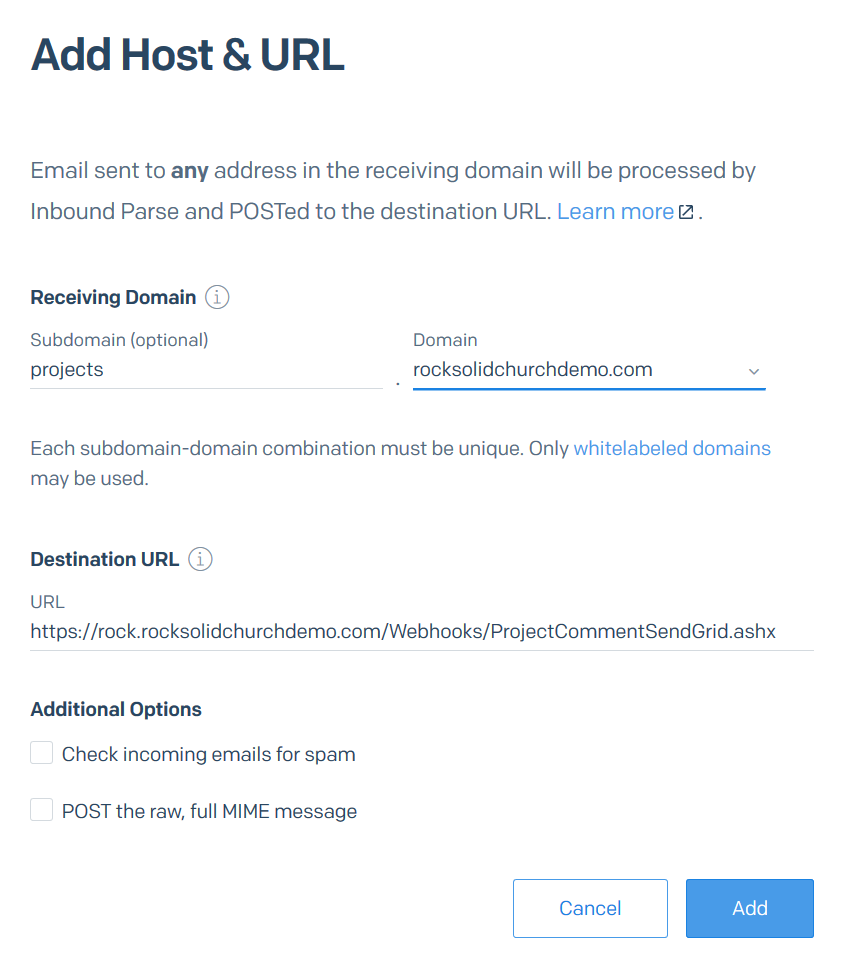
[!IMPORTANT]
Remember you will need to setup your DNS to have MX records for the subdomain selected and point them to SendGrid.
Templates
Out of the box, you are provided with a system e-mail for each of the four e-mail types below. Hopefully these will provide everything you need.
Occasionally the standard e-mail templates are updated. We will only modify them if you have not made changes yourself already. If you have made changes but want to incorporate the latest e-mail templates then you can find their contents below.
The subject for each template is as follows. There is some special syntax at the end which includes the Project Id and the Primary Alias Id of the person receiving the e-mail. This is required to support leaving comments by replying to a notification e-mail.
[Project] {{ Project.Name }} (#{{ Project.Id }}/{{ Person.PrimaryAliasId }})
Project Assigned
{{ 'Global' | Attribute:'EmailHeader' }}
<p>Hello {{ Person.NickName }},</p>
<p>
The project <a href="{{ Project.Id | BBM_ProjectRoute }}">{{ Project.Name }}</a>
was just assigned to you{% if CurrentPerson %} by {{ CurrentPerson.NickName }}{% endif %}.
</p>
<div>
<strong>Details:</strong>
<br />
{{ Project.Description | BBM_FromProjectMarkdown }}
</div>
<hr />
{% for attribute in Project.ProjectAttributes %}
{% if attribute.Value != '' %}
<div>
<strong>{{ attribute.Name }}:</strong><br />
{% if attribute.Url and attribute.Url != '' %}
<a href="{{ attribute.Url }}">{{ attribute.Value }}</a>
{% else %}
{{ attribute.Value | NewlineToBr }}
{% endif %}
</div><br />
{% endif %}
{% endfor %}
<p>
—<br />
<small><a href="{{ Project.Id | BBM_ProjectRoute }}">view it online</a>.</small>
</p>
{{ 'Global' | Attribute:'EmailFooter' }}
Task Assigned
{{ 'Global' | Attribute:'EmailHeader' }}
<p>Hello {{ Person.NickName }},</p>
<p>
The task <a href="{{ Project.Id | BBM_ProjectRoute }}">{{ Task.Name }}</a>
was just assigned to you{% if CurrentPerson %} by {{ CurrentPerson.NickName }}{% endif %}.
</p>
{{ Task.Description | BBM_FromProjectMarkdown }}
<p>
—<br />
<small><a href="{{ Project.Id | BBM_ProjectRoute }}">view it online</a>.</small>
</p>
{{ 'Global' | Attribute:'EmailFooter' }}
{{ 'Global' | Attribute:'EmailHeader' }}
{% if Comment %}
<p>New comment by @{{ Comment.CreatedByPersonAliasId | PersonByAliasId | Property:'FullName' }}:</p>
<div>
{{ Comment.Text | BBM_FromProjectMarkdown }}
</div>
{% else %}
<div>
{{ Project.Description | BBM_FromProjectMarkdown }}
</div>
{% endif %}
<p>
—<br />
<small><a href="{{ Project.Id | BBM_ProjectRoute }}">view it online</a>.</small>
</p>
{{ 'Global' | Attribute:'EmailFooter' }}
Project Completed
{{ 'Global' | Attribute:'EmailHeader' }}
<p>Hello {{ Person.NickName }},</p>
<p>
The project <a href="{{ Project.Id | BBM_ProjectRoute }}">{{ Project.Name }}</a>
has been completed {% if CurrentPerson %} by {{ CurrentPerson.NickName }}{% endif %}.
</p>
<p>
—<br />
<small><a href="{{ Project.Id | BBM_ProjectRoute }}">view it online</a>.</small>
</p>
{{ 'Global' | Attribute:'EmailFooter' }}
Lava Fields
The lava fields available in each e-mail are below.
All E-mails
"Project": {
"Id": 3,
"Name": "Light Switch Broken",
"Description": "The plastic plate for the light switch has cracked.",
"RequestDate": "2018-03-17 13:42:36",
"RequestedByPersonAliasId": 7,
"RequestedByPersonAlias": { ... },
"ProjectTypeId": 2,
"ProjectType": { ... },
"ParentProjectId": null,
"ParentProject": null,
"DueDate": null,
"CompletedDateTime": null,
"CancelledDateTime": null,
"BlockedDateTime": null,
"CategoryId": 1,
"Category": { ... },
"Projects": [ ],
"ParentProject": null,
"Assignees": [ { ... } ], /* PersonAlias records */
"BlockingProjects": [ ],
"BlockedProjects": [ ],
"Watchers": [ { ... } ],
"Tasks": [ { ... } ],
"IsBlocked": false,
"IsActive": true,
"ProjectAttributes": [
{
"Name": "test",
"Key": "test",
"RawValue": "Test value 1",
"Value": "Test value 1",
"IsEntryForm": true,
"IsRequired": false,
"Url": null
},
...
]
},
"Person": { ... } /* The person object who is receiving the e-mail. */
"CurrentPerson": { ... } /* The person object who initiated this action, if known. */
Project Assigned
No extra fields.
Task Assigned
"Task": {
"Id": 1,
"Name": "Order New Plate",
"Description": "",
"ProjectId": 3,
"Project": { ... },
"AssignedToPersonAliasId": null,
"AssignedToPersonAlias": null,
"Order": 0,
"DueDate": "2018-03-24 00:00:00",
"CompletedDateTime": null,
"CancelledDateTime": null,
"BlockedDateTime": null,
"BlockingTasks": [ ],
"BlockedTasks": [ ],
"IsBlocked": true,
"IsActive": true
}
"Comment": {
"Id": 1823,
"NoteTypeId": 92,
"NoteType": { ... },
"EntityId": 3,
"Text": "@Cindy Decker[15] can you check if this is a single or double wide plate?"
}
This e-mail type is also used when a project is first created if there was a mention to a person that would not otherwise receive an e-mail (such as project assigned). In these cases the Comment variable will be null.
Project Completed
No extra fields.